The North
Palermo
Capital and seat of the government of the region with more than 617,000 inhabitants. It was founded in the 3rd century BC by the Phoenicians, who called it Zyz (the flower). After the arrival of the Greeks, Palermo took the name of Panormus (all ports) due to its location in the bay overlooked by Monte Pellegrino and, it soon became an important naval base.Then came the Romans, the Byzantines, the Arabs and the Normans making Palermo a wonderful mix of styles showcased by a large number of religious and non-religious buildings.
Following the Norman reign of Sicily, other royal houses succeeded to the throne of Palermo:
The Swabians from 1194-1266, the Angevin from 1266-1282 who moved the capital from Palermo to Naples. After the Sicilian Vespers rebellion, Palermo became the capital of the kingdom.In 1860, Garibaldi landed at Marsala and with the help of the Sicilians began to conquer the island in the name of the unification of Italy which happened in 1861.Subsequently, the city of Palermo has undertaken the construction of some impressive important works such as the two theatres which are most representative of the city, the Teatro Massimo and the Teatro Politeama.In the first twenty years of the 20th century, Palermo flourished alongside the brief but intense Art Nouveau period.
Not damaged by World War I, it did suffered considerable destruction by bombing during World War II.
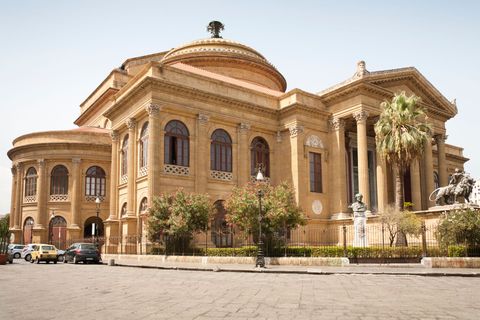
To see
The Royal Palace which is also known as the Norman Palace. The Arabs built a fortress on an ancient Punic and Roman structure. Then the Normans made it the headquarters of all their political activities.Today, it is the seat of the Sicilian Regional Assembly.In 1132, a chapel was built inside the palace at the behest of King Roger. Described by Guy de Maupassant as "the most beautiful church in the world,"it was the place of worship of the royal family and was dedicated to Saints Peter and Paul.Famous for its many beautiful mosaics.The Chiesa di San Giovanni degli Eremiti (St. John of the Hermits, 11th century) is famous for its domes and Arabic features.The Martorana or Santa Maria dell'Ammiraglio (St. Mary of the Admiral), the Greek-Orthodox church, is a magnificent Norman building constructed by Admiral George of Antioch in 1143. The church contains beautiful mosaics and is a blend of Byzantine and Baroque art. Church of San Cataldo (11th century). Piazza della Vergogna . Palermo Cathedral is dedicated to the Assumption of the Virgin Mary. This impressive building was constructed on the site of an ancient basilica which had already been converted into a mosque by the Arabs. The building reflects the different architectural styles present in Sicily from the 12th to the 19th century. The relics of Saint Rosalia, the city's guardian, lie in a chapel inside the church. The Zisa. Santa Maria della Spasimo . The Foro Italico The sancturay of Santa Rosalia is on Monte Pellegrino, the sacred mountain of the Palermitani. A place of pilgrimage since the 17th century, it displays the devotion of the people through the characteristic votive offerings brought by the faithful who have had favours granted. The Chinese Palace. The Botanical Gardens with an area of about 10 hectares, is among the richest in Europe.The Teatro Massimo, one of the largest and most magnificent in Europe built between 1875 and 1897 and the Teatro Politeama.
The Capuchin Catacombs which house a baroque style "macabre display" of the bodies of 8,000 Palermitani, mummified and dressed in fine clothes.Capo or Vucciria markets whose colours remind us of the ancient Arab markets in the city.The Monreale Cathedral: the Cathedral of Wilhelm II, whose walls are covered with Byzantine-style mosaics depicting biblical scenes and episodes from the Gospels.
Cefalù
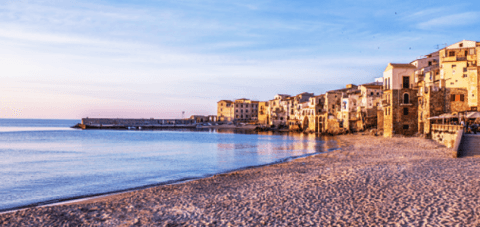
A medieval town dominated by an imposing rock where the remains of the Temple of "Diana"are located. Its celebrated 12th-century cathedral, with its elegant façade and the apse entirely covered in mosaic images of Christ Pantocrator.Also worth seeing is the medieval wash-house (Norman-Arabic) carved into the rock.
Castelbuono
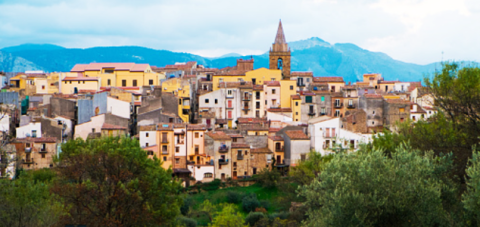
A town within the Madonie Mountains which gives a glimpse into the life of a Sicilian village. The Ventimiglia Castle dates from the 13th century and is a robust construction of Arab-Norman-Swabian architecture. The interesting church of the Matrice Vecchia dating from the 14th century has a Romanesque-Gothic style, with a 16th-century portico, frescoes and other Sicilian works from the 1400s and 1500s.
Santo Stefano di Camastra
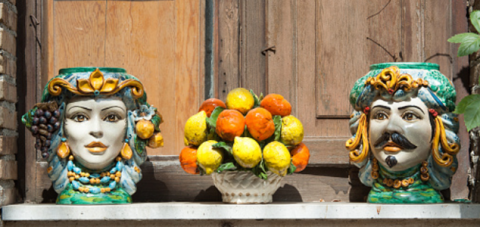
Picturesque fishing village renowned for its production of ceramics
Messina
A town with an economy based on the cultivation of citrus fruits, fruits, vegetables and wines.It is also a great center of commerce and tourism and is located in the extreme north-east of Sicily, 90 km from Catania and 220 km from Palermo.Founded as a Greek colony called Zancle then Messana, Messina was at the pinnacle of its greatness between the late Middle Ages and the mid 17th century.In 1783, it was damaged by a large earthquake, followed by another in 1908 that almost completely destroyed the city and caused the death of half its population.
To see:
The cathedral, one of the oldest churches in Sicily, built in 1160 during the reign King Roger II.It was the victim of a fire in the 13th century, earthquakes and more recently, allied bombing in 1943.A Norman building with a beautiful façade and three magnificent portals from the 15th and 16th centuries.Inside comprises the roof in painted wood, and numerous tombs and treasures.Adjacent you can find the bell tower which houses the largest astronomical clock in the world which was built in 1933 in Strasbourg.
The church of Santa Maria Alemanna from the 13th century.
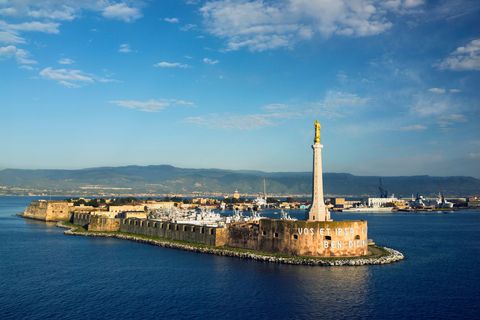
The church of Santa Maria Annunziata of the Catalans, built in the 12th century during the reign of the Normans.It is an example of a fusion of Byzantine, Roman, Arabic and Norman styles.
The Fountain of Neptune from 1557 and the 16th-century Fountain of Orion which depicts one of the mythical founders of the city.
Aeolian Islands
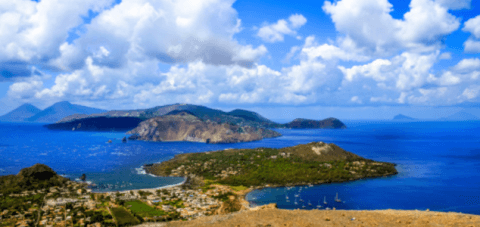
The Aeolian Islands (also called Lipari) are a volcanic archipelago north of Sicily, formed about a million years ago.The name comes from King Aeolus who dominated the archipelago during the Trojan War.
The islands are known for the beauty of their sea and according to archaeological research on the seabed, the first inhabitants were the Sicilians in the Neolithic period.
Vulcano
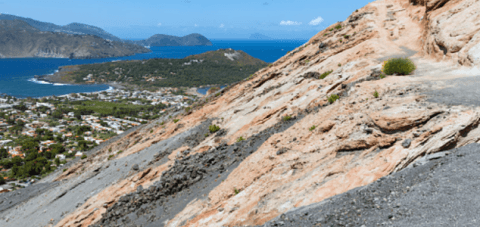
This island is an active volcano. The island is formed by four volcanoes and is known for its marine beauty.Things to see are the Faraglioni (two solidified magma rocks), the Grotta deglie Angeli (Cave of Angels), the Grotta dei Cavalli (Cave of horses), the Piscina di Venere (Pool of Venus), the famous healing mud baths and the beautiful black sand beach.
Stromboli
The northernmost island of the archipelago sits at an altitude of 924 m above sea level and is the most active volcano in Europe. Its eruptions occur on average every hour with showers of lapilli (small stones), ash and volcanic "bombs".
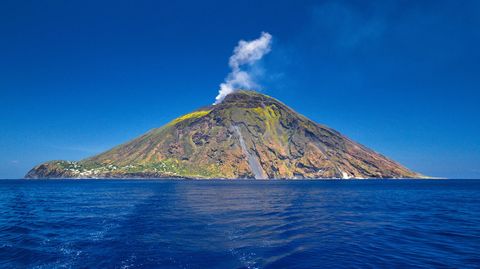
Lipari
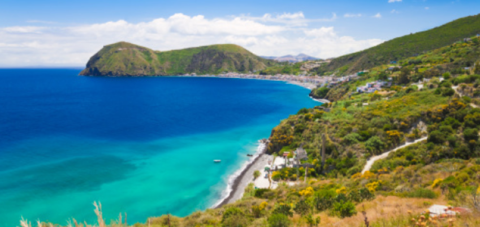
The largest island, which houses the Archaeological Museum of the Aeolian islands. Once the commercial centre for production of obsidian, a volcanic glass, and now the largest producer of pumice stone.






